
Profile photo: Bobcat by Wayne Dumbleton via Creative Commons
The bobcat (Lynx rufus) is an adaptable predator of the cat family Felidae that inhabits wooded areas, as well as semidesert, urban edge, forest edges, and swampland environments from southern Canada to northern Mexico, including most of the continental United States.
The bobcat is vital for controlling pest populations. With a gray to brown coat, whiskered face, and black-tufted ears, the bobcat is about twice as large as the domestic cat. It has distinctive black bars on its forelegs and a black-tipped, stubby tail, from which it derives its name.
Though the bobcat prefers rabbits and hares, it will hunt anything from insects, chickens, geese and other birds and small rodents to deer. Prey selection depends on location and habitat, season, and abundance. Like most cats, the bobcat is territorial and largely solitary, although with some overlap in home ranges.
Bobcats have been hunted extensively by humans, both for sport and fur, their population has proven resilient though declining in some areas.
EVOLUTION
Bobcats (Lynx rufus), are one of four extant felid species in the lynx genus. Modern day bobcats are believed to have evolved from the Eurasian lynx (Lynx lynx) which entered the US by means of the Bering land bridge about 2.5 million years ago.
THREATS
Even though bobcats are not currently threatened with extinction and have a generally stable population status, hunting and trading must be closely monitored along with a variety of other threats facing this species.
ECOLOGICAL ROLE
Similar to other large felid species, bobcats are top predators that exert top-down regulation over their ecosystems.
COEXISTENCE
Although bobcat predation of domestic animals is rare, there are steps that can be taken to prevent these instances from occurring and lethal retaliation that often follows.
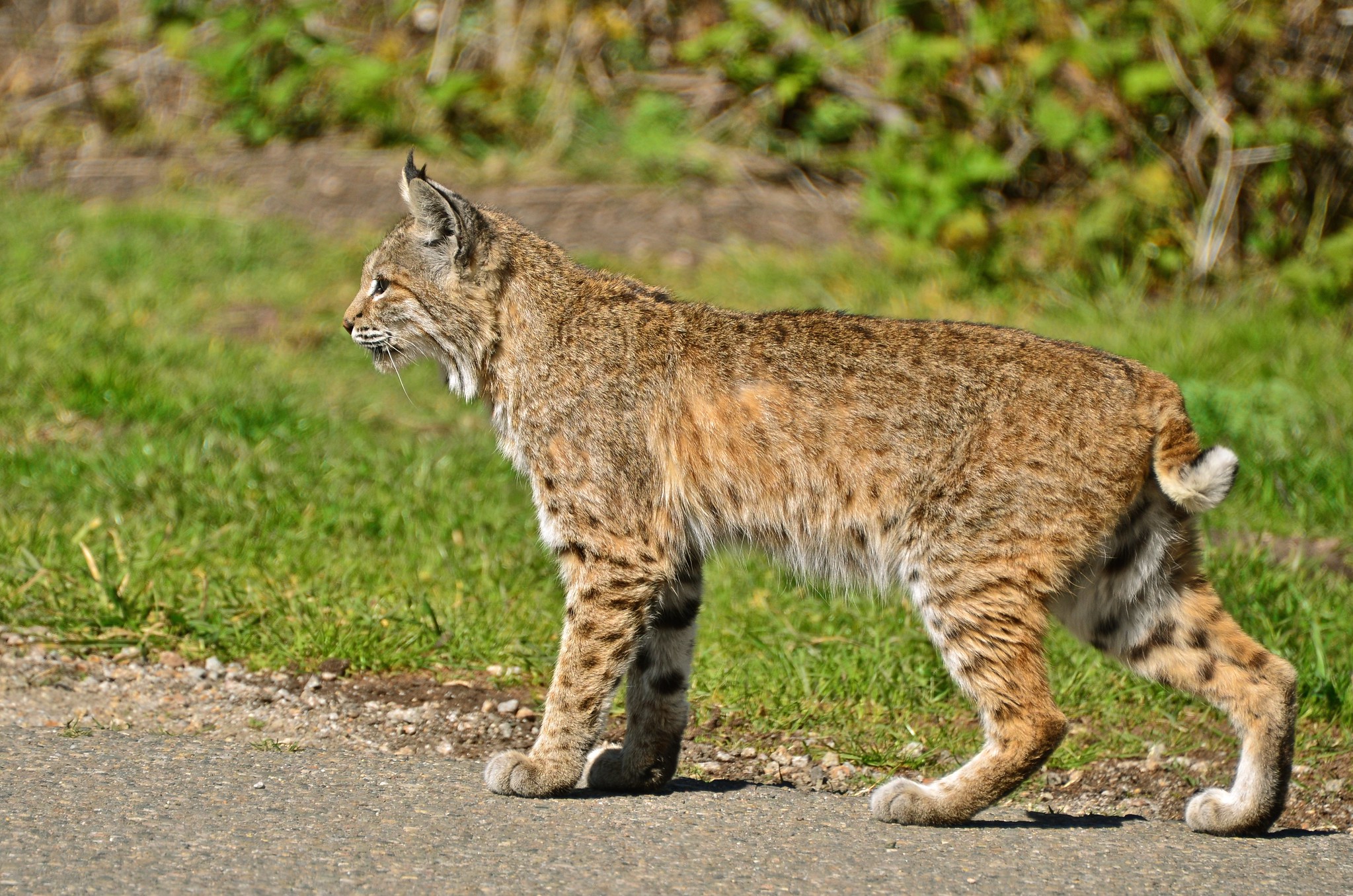
EVOLUTION
Bobcats (Lynx rufus), are one of four extant felid species in the lynx genus (New World Encyclopedia). Modern day bobcats are believed to have evolved from the Eurasian lynx (Lynx lynx) which entered the US by means of the Bering land bridge about 2.5 million years ago (New World Encyclopedia). The first lynx to arrive in the US inhabited the south and were physically separated from the northern US by glaciers. About 20,000 years ago, this population in the South evolved into the modern bobcat while a second population from Asia occupied the North and evolved into the Canadian lynx (Lynx canadensis).
“Mama Bobcat – A Series” by goingslo via Creative Commons.
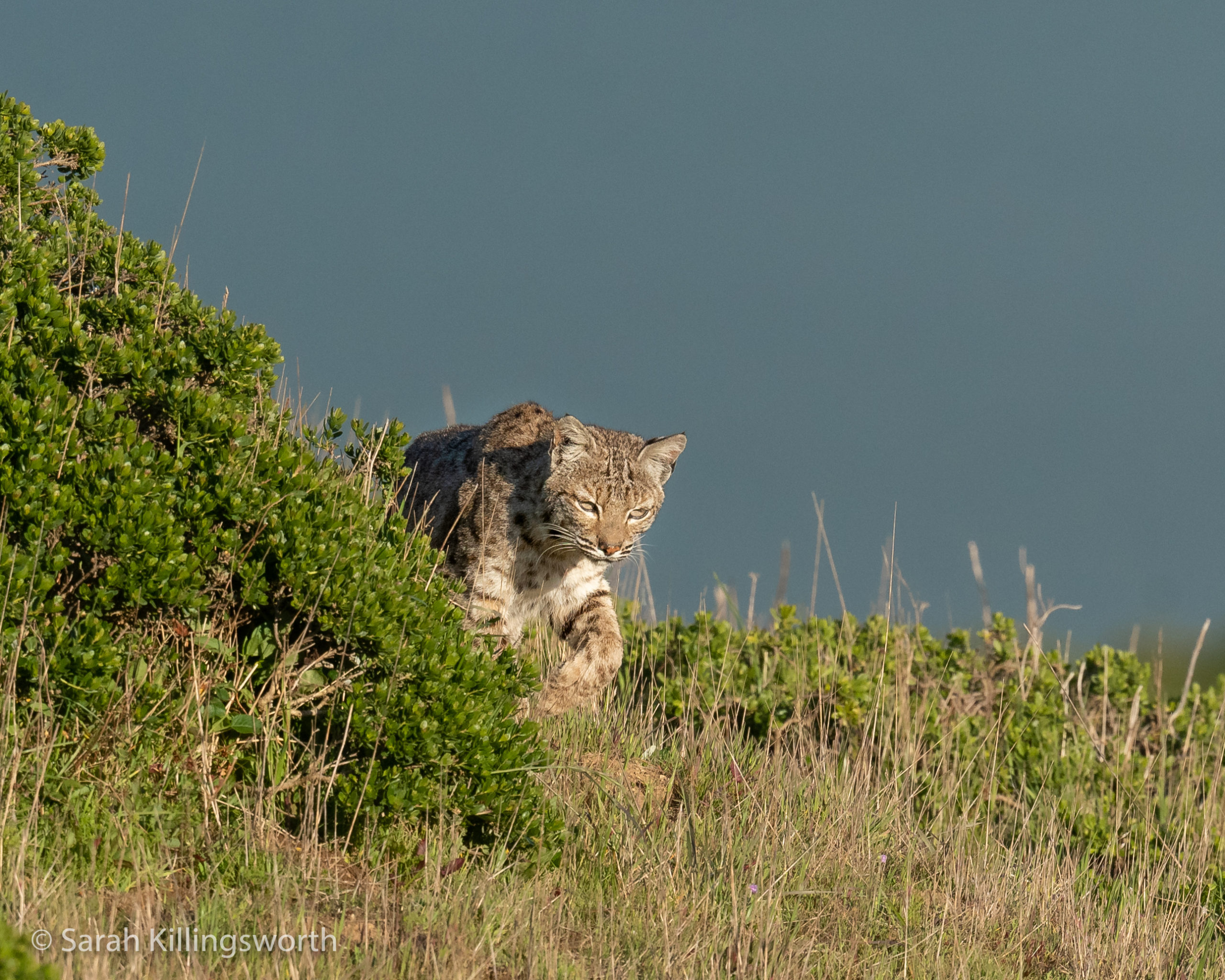
DISTRIBUTION
The bobcat is the most widely distributed and abundant felid in North America (Association of Fish and Wildlife Agencies). Its range spans North America from the south of Canada to the south of Mexico (Ciszek, 2002). Bobcats are found in every contiguous state within the US except Delaware (Kelly et al., 2016), and have higher population densities in the southeast than in western states (Ciszek, 2002). Bobcats are thought to no longer exist in parts of the Midwest/Northeast in areas such as southern Minnesota, eastern South Dakota and parts of Missouri due to agricultural-related habitat fragmentation (New World Encyclopedia). Overall, bobcats are an adaptable species and their range is not limited by human presence except in areas of intensely cultivated tracts (New World Encyclopedia).
HABITAT
Within their geographic distribution, bobcats prefer habitats such as forests, semi-deserts, mountainous regions, and brushlands (Ciszek, 2002). Bobcats primarily prefer habitats with dense understory vegetation and high prey density, and generally prefer woodland habitats (New World Encyclopedia). However, bobcats are fairly adaptable and can even be found in humid swamp ecosystems in Florida (New World Encyclopedia). Bobcats tend to make their dens in sheltered areas such as hollow trees, thickets, and rocky crevices (Ciszek, 2002). Bobcats prefer these sheltered areas as they stalk while hunting, and need cover to hide (New World Encyclopedia).
The preferred habitats of bobcats also heavily depend on the abundance and availability of prey species (Kelly et al., 2016). Typical bobcat habitats usually have high densities of rabbit and rodent populations (Kelly et al., 2016).
Bobcat by Sarah Killingsworth.
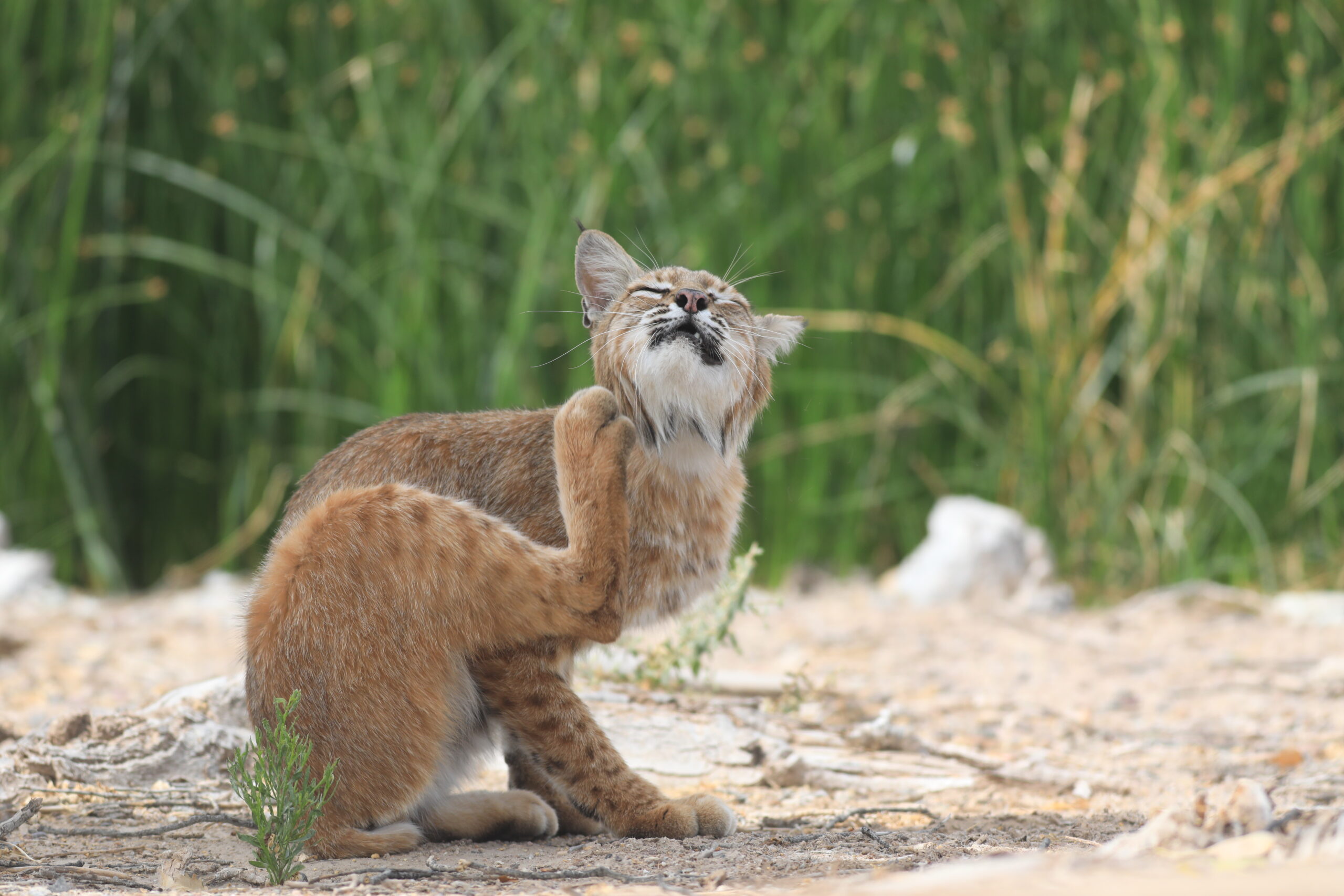
SOCIAL STRUCTURE
Overall, bobcats tend to be solitary, with male and female bobcats typically only associating with one another during breeding and copulation (Ciszek, 2002). The mating system of bobcats is polygynandrous/promiscuous, in which both females and males breed with multiple mates (Ciszek, 2002). Bobcats breed once a year, usually in early spring (Ciszek, 2002). Their gestation period is between 50-70 days, and they have on average 3 kittens per litter (Ciszek, 2002). After giving birth, it takes about 8 months for the kittens to become independent, and the mothers are solely involved in the rearing of these kittens (Ciszek, 2002). Bobkittens will typically begin hunting by themselves by the fall of their first year, and will begin to disperse soon after this (New World Encyclopedia).
Bobcats are a territorial species and use several methods to delineate their home range. They use claw markings, urine, feces, and anal gland secretions to mark their territories (Ciszek, 2002; 6). The home ranges of males generally overlap with those of females and potentially other males as well, and research indicates that territory and home range establishment is vital for breeding success (Ciszek, 2002, New World Encyclopedia). While females are rearing their kittens, males are focused on defending their territory and searching for mates (Conner et al., 1999; Sunquist & Sunquist, 2009). Male territories tend to be 2-3 times larger than those of females (Conner et al., 1999; Sunquist & Sunquist, 2009).
APPERANCE
Bobcats are about twice the size of domestic cats, and their coats are buff and brown colored with dark brown/black stripes and spotting (Ciszek, 2002). The tips of their tails and their ear tips are black, and they have short tufts of hair on their ears and on the sides of their head (Ciszek, 2002). Bobcats get their name from their distinctly short tails (11-19 cm, 4-7 in, ) that have a “bobbed” look (Ciszek, 2002). Bobcats are generally 65-105 cm (26-41 in) from their nose to the tip of their tail (Ciszek, 2002). They are about 45-58 cm (18-23 in) tall, and weigh about 4-15 kg (9-33 lb) (Ciszek, 2002).
Bobcats are commonly mistaken for lynx, which also have short tails. However, the tail of the lynx is actually shorter and stubbier than that of the bobcat, and bobcats have striped tails while lynx have tails with a black tip (Joy of Animals). While bobcats have tufts of hair around their ears, lynx have distinct long, black, and thin tufts of hair standing at the tips of their ears (Joy of Animals). In addition to these tufts, lynx also have longer legs than bobcats, are generally larger, and are found in northern habitats, such as the boreal forests of Canada and Alaska (Ciszek, 2002).
DIET
Bobcats are carnivorous felids and opportunistic predators (New World Encyclopedia). This means they will change their strategies and diets depending on environmental circumstances and prey availability. For instance, if one of the bobcat’s main prey declines in their habitat, bobcats will diversify their diet.
The majority of a bobcat’s diet consists of small mammals, usually between 1.5-12.5 lb (New World Encyclopedia). Rodents and rabbits comprise a large part of the bobcat diet, but bobcats also consume squirrels, birds, fish, and even insects (New World Encyclopedia). They will sometimes hunt larger mammals such as deer and other ungulates and return to their kills to feed on them later (New World Encyclopedia). Occasionally, bobcats will hunt domestic animals such as sheep, goats, and poultry , although these do not make up a significant portion of their diet. For example, in 2004, bobcats accounted for 4.9% of predator-caused sheep deaths (New World Encyclopedia).
Bobcats are excellent hunters, and use stalking and ambush techniques. They can run up to 30 mph and can travel up to 7 miles each day searching for prey in their territory (Smithsonian’s National Zoo). When stalking prey, they will wait in covered areas for the prey to come near, and then they will pounce and deliver a bite to the vertebrae of their target (6, Ciszek, 2002). To reduce sound while stalking, bobcats place their back paws in the tracks made by their front paws (Smithsonian’s National Zoo).
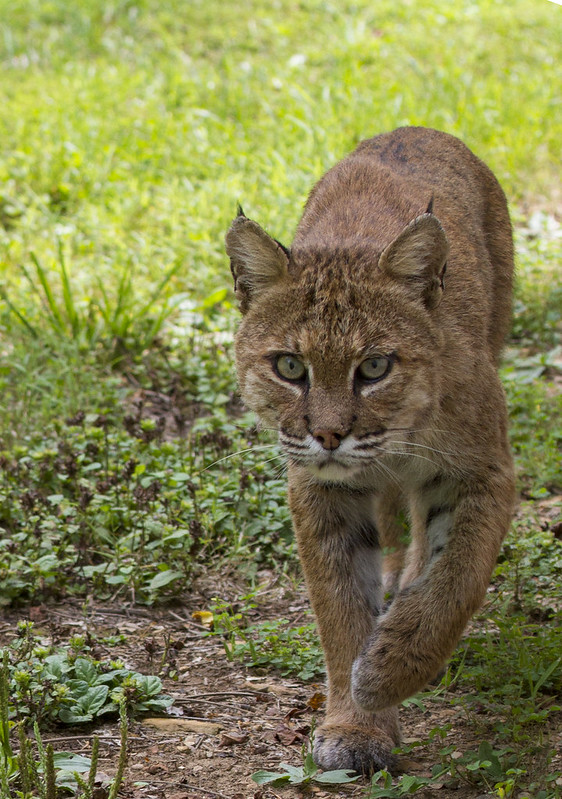
Bobcat by ShenandoahNPS via Creative Commons
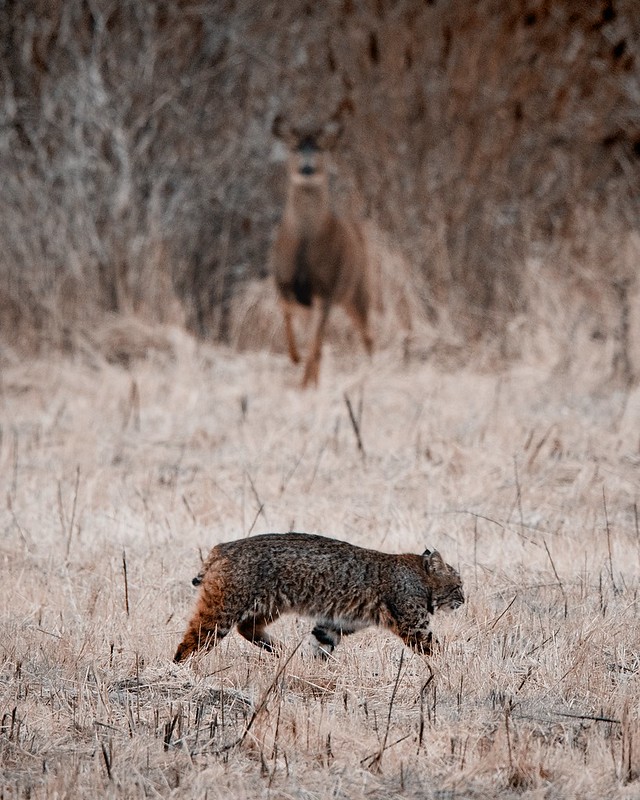
Bobcat walks by while a deer stands still in the background by Eddie Black via Creative Commons.

THREATS
Currently, according to the IUCN, the conservation status of bobcats is of least concern (Kelly et al., 2016). Bobcat populations in North America are currently stable, and there are about 700,000 to 1,500,000 in the US (New World Encyclopedia). However, there have been declines in the American Midwest and this species is considered to be endangered in Ohio, Illinois, and New Jersey. Even though bobcats are not currently threatened with extinction and have a generally stable population status, hunting and trading must be closely monitored along with a variety of other threats facing this species (New World Encyclopedia).
During the turn of the 19th century, commercial and agricultural developments caused habitat fragmentation and contributed to population declines in New Jersey (New World Encyclopedia). Later, in the 1970s and 1980s, there was an unprecedented price spike for bobcat furs that triggered an increased demand and interest in hunting this species (New World Encyclopedia). Prices for bobcat furs began rising in the early 70s, and dramatically increased from about $85/fur in 2000 to record highs of $589 in 2013 (Kelly et al., 2016). There was a high global demand for these furs especially in China, Europe, and Russia (Kelly et al., 2016). As a result of this demand, bobcat fur exports from the US quadrupled in recent years and reached a high of 65,000 in 2013 (Kelly et al., 2016). Despite this, the US government has concluded that trade is not detrimental to the persistence and survival of Bobcats, and is well-managed (Kelly et al., 2016). For this reason, there have been many arguments advocating for the removal of the bobcat from CITES (Kelly et al., 2016).
In addition to the threat of hunting and trade, habitat loss is a primary threat to this species despite the adaptability of bobcats (Kelly et al., 2016). Increased development and urbanization and increases in the prevalence of roads are disrupting bobcat dispersal and are contributing to genetic isolation (Kelly et al., 2016). Vehicle collisions and exposure to toxic substances such as rodenticides are also threatening bobcat populations within human-dominated landscapes (Kelly et al., 2016). Researchers speculate that exposure to rodenticides–especially those containing anticoagulants–is increasing the susceptibility of bobcats to a skin disease known as notoedric mange (U.S. Department of the Interior). Notoedric mange, also known as scabies, is a skin infestation caused by mites that can contribute to skin lesions and secondary infections (U.S. Department of the Interior).
ECOLOGICAL ROLE
Similar to other large felid species, bobcats are top predators that exert top-down regulation over their ecosystems. Bobcats help regulate rodent and rabbit populations in their habitats, and indirectly support vegetation by keeping population numbers of browsers in check.
Bobcats have an extensive geographic distribution in North America and subsequently overlap with other predators such as coyotes and the red fox, but little evidence for competitive relationships between these species exist (New World Encyclopedia). However, some interspecific competition exists between bobcats and lynx which impacts distribution patterns. Specifically, the presence of bobcats has likely contributed to the competitive exclusion of lynx from more southern habitats (New World Encyclopedia).
TIPS FOR COEXISTENCE
While there is little evidence that bobcats consume substantial amounts of domestic ruminants, poultry, or companion animals, occasional predation often leads to persecution and poaching (Kelly et al., 2016). Poaching of bobcats has contributed to population declines in states like New Hampshire (Kelly et al., 2016).
Although bobcat predation of domestic animals is rare, there are steps that can be taken to prevent these instances from occurring and lethal retaliation that often follows. First and foremost, it is important to recognize that bobcats are predators with wild instincts to hunt. Therefore, it is the responsibility of people to protect their pets and for farmers to protect their livestock (McIntire, 2021). These preventative measures can include keeping pets on leashes, monitoring pets when they are outside, and constructing barriers around livestock to prevent depredation from occurring.
Bobcat by Sarah Killingsworth.
LITERATURE CITED
Association of Fish and Wildlife Agencies. (n.d.). CASE STUDY: STATE AND FEDERAL MANAGEMENT OF THE BOBCAT in the Context of the Convention on International Trade in Endangered Species of Wild Fauna and Flora (CITES). Retrieved September 13, 2022, from https://wildlife.onlinelibrary.wiley.com/doi/10.2193/2005-615
Baraoidan, S., & Boughton, R. K. (2018, August). Bobcat. University of Florida. Retrieved from https://edis.ifas.ufl.edu/pdf/UW/UW44400.pdf
Bobcat. New World Encyclopedia. (n.d.). Retrieved September 13, 2022, from https://www.newworldencyclopedia.org/entry/Bobcat
Bobcat. Smithsonian’s National Zoo. (2022, May 27). Retrieved September 13, 2022, from https://nationalzoo.si.edu/animals/bobcat
Ciszek, D. 2002. “Lynx rufus” (On-line), Animal Diversity Web. Accessed September 13, 2022 at https://animaldiversity.org/accounts/Lynx_rufus/
Conner M, Plowman B, Leopold BD, Lovell C. 1999. Influence of time-in-residence on home range and habitat use of bobcats. J Wildl Manag. 63(1):261. doi:10.2307/3802508.
Joy of Animals. (2019, April 20). Bobcat vs Lynx – what’s the difference? Joy of Animals. Retrieved September 13, 2022, from https://www.joyofanimals.com/bobcat-vs-lynx-difference/#:~:text=While%20the%20bobcat%20takes%20its,a%20much%20more%20modest%20ruff
Kelly, M., Morin, D. & Lopez-Gonzalez, C.A. 2016. Lynx rufus. The IUCN Red List of Threatened Species 2016: e.T12521A50655874. https://dx.doi.org/10.2305/IUCN.UK.2016-1.RLTS.T12521A50655874.en. Accessed on 13 September 2022.
McIntire, M. (2021, June 23). Taking the fear out of living with Bobcats. Friends of Animals. Retrieved September 13, 2022, from https://friendsofanimals.org/taking-the-fear-out-of-living-with-bobcats/
Nunley, G. L. (1978). Present and historical bobcat population trends in New Mexico and the West. Proceedings of the Vertebrate Pest Conference, 8. Retrieved from https://escholarship.org/uc/item/2430q5qb
Sunquist ME, Sunquist FC. 2009b. Bobcat Lynx rufus. In: Wilson DE, Mittermeier RA, editors. Handbook of the mammals of the world: carnivores (volume 1). Barcelona (Spain): Lynx Edicions. p. 149-150.
U.S. Department of the Interior. (n.d.). Researchers investigate link between rodenticides and Mange in Bobcats (U.S. National Park Service). National Parks Service. Retrieved September 13, 2022, from https://www.nps.gov/articles/researchers-investigate-rodenticides-and-mange-in-bobcats.htm
